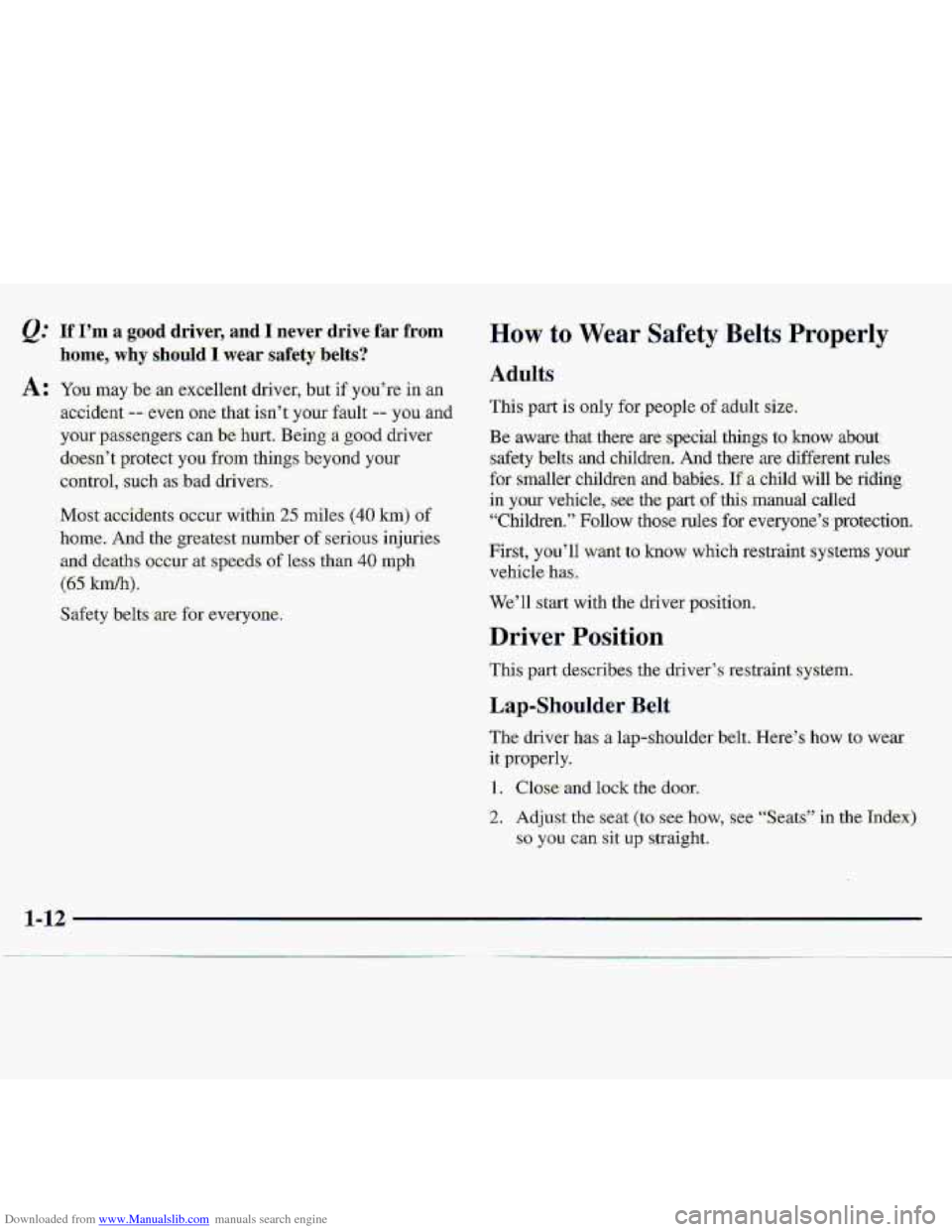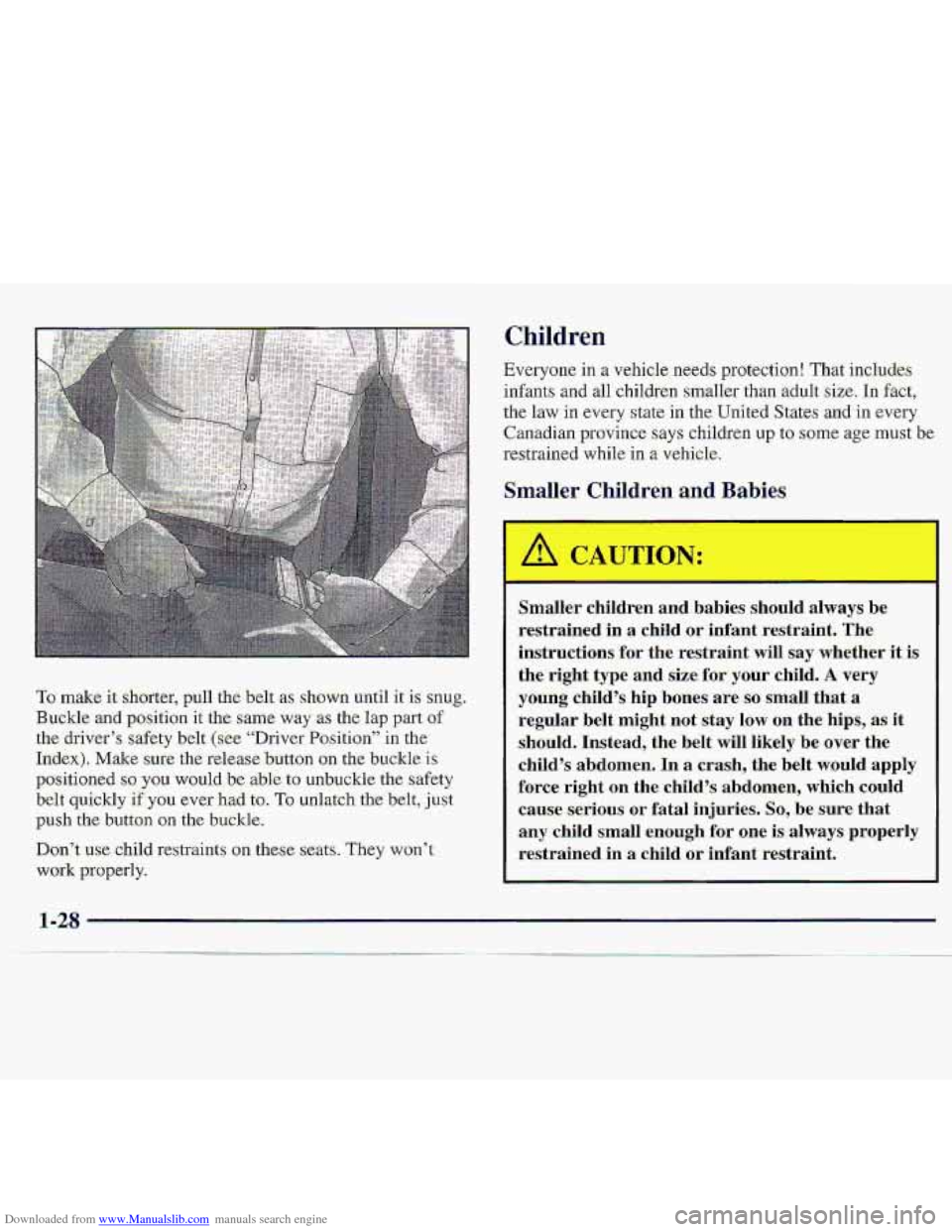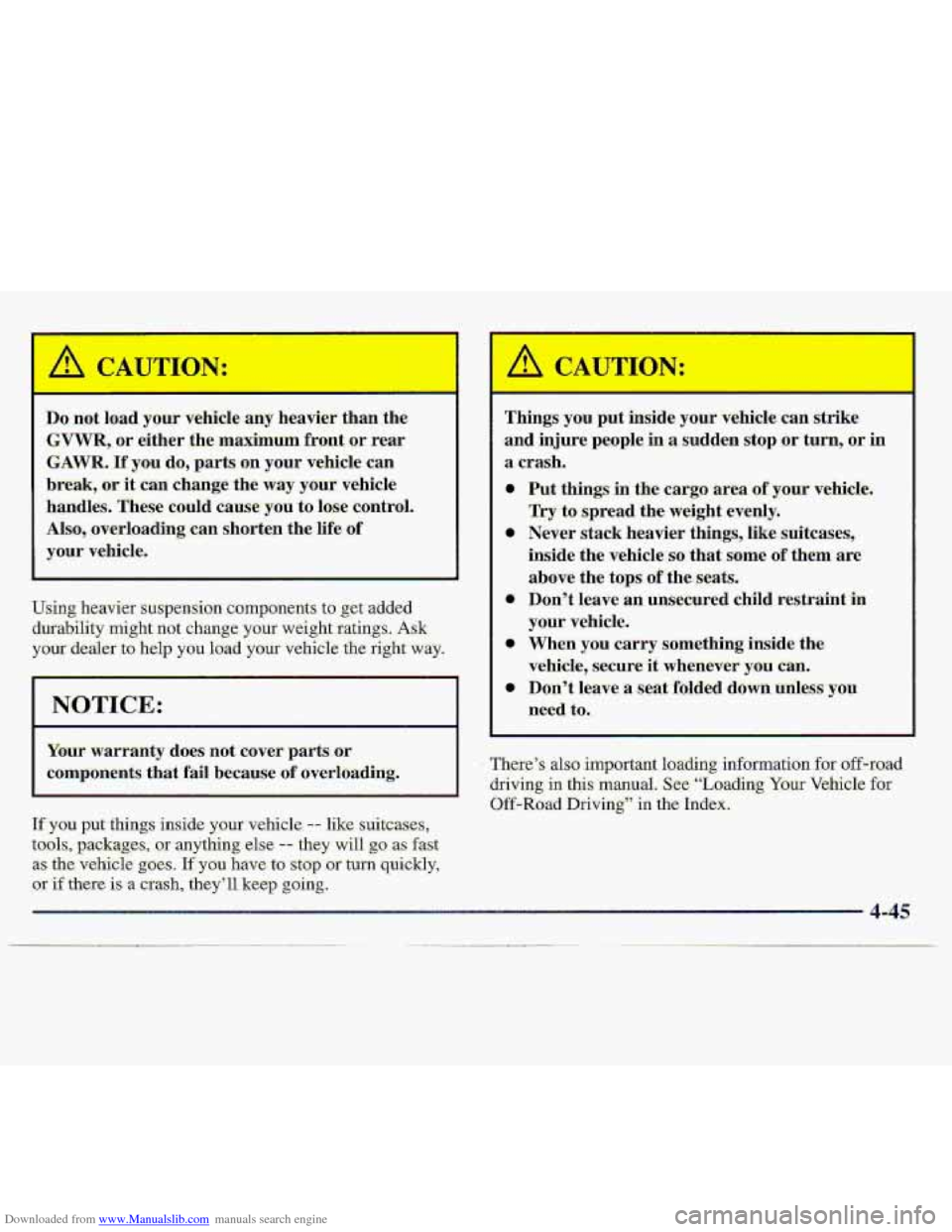Page 8 of 402
Downloaded from www.Manualslib.com manuals search engine Section 1 Seats and Restraint Systems
Here you’ll find information about the seats in your vehicle and how to use your safety belts properly. You can also
learn about some
things you should not do with air bags and safety belts.
1-2
1-7
1-11
1-12
1-12 1-19
1-25
1-25 Seats
and Seat Controls
Safety Belts: They’re for Everyone
Here Are Questions Many People
Ask About
S.afety Belts
-- and the Answers
How
to Wear Safety Belts Properly
Driver Position
S.upplemental Matable Restraint
(SIR)
System
Safety Belt
Use During Pregnancy
Right Front Passenger Position 1-25
1-27
1-2.8
1-30
1-34
1-37
1-37
1-38 Center Passenger
P.osition
Rear Seat Passengers
(Extended Cab
Jump Seats)
Children
Child
Restraints
Larger Children Safety Belt Extender
Checking Your Restraint Systems
Replacing Restraint System Parts After
a Crash
1-1
Page 19 of 402

Downloaded from www.Manualslib.com manuals search engine If I?rn a good driver, and I never drive far from
hame, why should I wear safety belts?
A: You may be an excellent driver, but if you’,re in an
accident
---even one that isn’t.your fault -- you and
your
passefigers can be hurt. Being a: gciod.driver
, d9esn”t prqtect you. from things beyond your
cantrd, such mbad drivem
Most accidents
occur within 25 miles (40 km) of
home. And the g:reatest number of serious injuries
and deaths occur
at speeds of less than 40 mph
(65 Wh).
Ho.w to Wear Safety Belts ‘Properly
Adults
This part is only for people of adult size.
Be aware .that there
are special things to know about
safety belts
and children. And there are different rules
for smaller children
and babies. If a.child will be ridag:
.in your vehicle,
see the part of this: m,anual called
“Children.” Follow those
rules for everyone’s protection.
First, you’ll
want to know which restraint systems your
vehde- has:.
We’ll
start with the driver positioa. Safety b.elts are for everyone.
Driver Position
This partdescribes the driver’s restraint system.
Lap-Sho.uld.er. B.elt
‘The driver has a lap-should€ - relt, Her( ho.w to wear
it properly.
I.. Close and lock the door.
2. Adjust the seat (to see how, see ‘Seats” in the Index)
so you c.an sit up straight.
1-12
Page 35 of 402

Downloaded from www.Manualslib.com manuals search engine Childr 1
To make it shorter, pull the belt as shdwn until it is snug,.
Buckle and position it the same way as thelap pxrt of
,,the driver’s safety bdt (see “Driver Position” in the
,Index).
Make sure the: release button on the buckle. is
positioned so you would Ine .able to unbuckle the safety
belt quickly
if you ever had to. To unlatch the be:lt, just
push the button on the buckle.
Don’t use child restraints on these seats. They won’t
work properly. Everyone
m a
vehic1.e needs protection! That includes
infants
and all children smaller than adult size. In fact,
the
law in every state in the United States and--in every
Canadian province says children up to some age must
be
restrained while in a vehicle.
Smaller Children and Babie-s
Smaller children and babies s.hould always be
.restrained in
a child or infant restraint. The
instructions for
the restraint will say whether it is
.the right type
and size for your child. A very
young child’s hip
bones are so small that a
regular belt might not stay low on the hips, as it
.should. Instead, the belt will likely be over the
child’s abd,omen. In
a crash, the belt would apply
.force right on the child’s abdomen, which could cause serious or fatal injuries.
So, be sure that
any child small enough
for one is always properly
restrained in
a child or infant restraint.
1-28
Page 38 of 402
Downloaded from www.Manualslib.com manuals search engine Securing a Child Restraint in the Center
Front
Seat Position
Don’t use child restraints in this position. The restraints
won’t work properly.
Jump Seats (Extended Cab)
Don’t use child restraints in these positicms. The
restraints. won’t
workproperly.
Page 39 of 402
Downloaded from www.Manualslib.com manuals search engine S.e.curing a Child. ]Restraint-in the Right
Front
Seat PosMo,n,
You'll be using the hp-shoulder.belt. See the earlier part
about the top .strap if the child restraint has one..
1. Put the. restraint on the seat. FollQw The instructions
for the child i-estraifk
'2. Secure the cluld in the- child.re.straint as the
instruckions say.
3. Pick up the latch plate., and run thelap 2nd Bhouldex
portions
of the: vehicle's sakty belt through dr
wound the.restraint. The child restraint instrwtians
wilhhow you how.
If the shoulder bell goes. in front of the. childls face or
neck, put it behind the child restraint.
Page 42 of 402
Downloaded from www.Manualslib.com manuals search engine Never do this. Here
two children are wearing the same belt. The
belt can’t properly spread the impact forces.
In a
crash, the two children-can be crushed together
and seriously injuted.
A belt must be used by
only
one person at a time.
&: What if a child is wearing a lap-shoulder belt,
but the child is SO small that the shoulder belt is
very close to the c-hi1d”s face or neck?
A: Move the child toward the center of the vehicle, but
be surethat the shoulder belt still is onthe child’s
shoulder, so that in si crash the child’s ~ip.per body
would have the restraint that belts provide. If the
child
is so small that the shoulder belt is still vc1-y
close.to the child’s face or neck, you might warit to
place. the child
in a seat that has a lap belt, if your
vehi-ck has one.
Page 43 of 402
Downloaded from www.Manualslib.com manuals search engine Never do this.
Here a child is sitting
in a seat that has a
lap-shoulder belt,
but the shoulder part is behind
the child.
If the child wears the .belt in this way, in
a crash the child might slide under the-belt. The
.belt’s force would then be applied right on the
child’s abdomen. That
could cause serious or
fatal injuries.
Wherever the child sits, the lap portion of the belt
shuu1.d be worn low and snug on the hips, just touching
the child’s thighs. This applies belt force to the child’s
pelvic b0ne.s in a crash.
1-36
Page 182 of 402

Downloaded from www.Manualslib.com manuals search engine A CAUTION:
Do not load your vehicle any heavier than the
GVWR, or either the maximum €ront .or rear
GAWR. Ifyou do, parts on your vehicle can
break, or it can change the way your- vehicle
handles. These couId cause-you to lose control.
Also, .overloading can shorten the life of
~ your vehicle.
Using he-avier s.uspension comp'onents to get added
durability might not
change. your weight ratings. Ask
your dealer to help you load your vehicle the right way.
I NOTICE.:
Your warranty does not cover-parts. or
components that fail because of overloading.
If you put t Igs imide your vehicle. -- like suitcases,
tools, p.ackages, ~r anything else -- they will go as fast
as.
ae. vehicle goes. 1f'yo.u have t~ st0.p or turn quickly,
or if there is a crash, they'll keep going.
h CAUTION:
Things you pnt inside your vehicle can strike
-and .injure people in-a- sudden
stop or-turn-, 0r.m
a. crash.
0. Put things in the cargo area .of your vehicle.
Try to spread the weight evenly.
Never stack heavier things, like .suitcases.,.
inside the vehickso that
some of them are
above the top.s'of 'the seats.
0- Don't leave 'an unsecured child restraint in
your vehicle.
@ When you carry something inside the
vehicle, secure. it whenever yon can.
+. Don't leave a seat-folded down mle!sS you
need tu.
There's also important loading information for off -road
driving in this manual. See "Loading Your- Vehicle for
Off-Road Driving" in the Index.
4-45